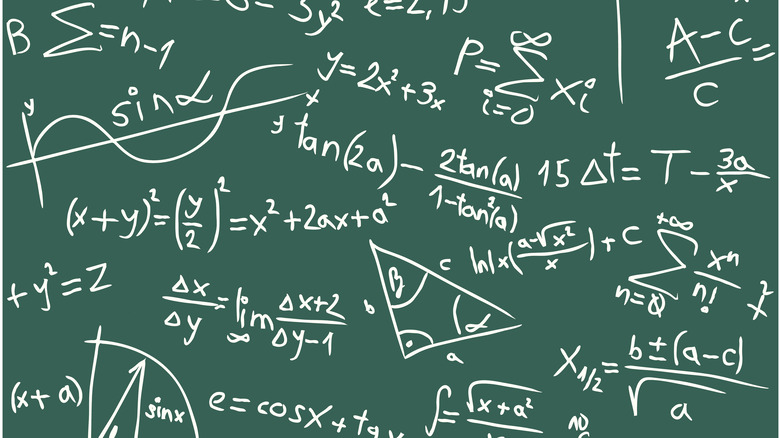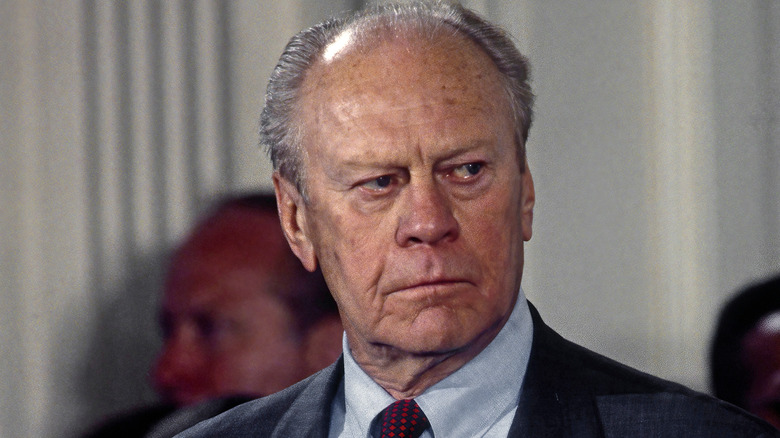Who Was George Dantzig, UC Berkeley's Real Life Will Hunting?
Imagine arriving to class late and seeing math problems on the chalkboard. A young graduate student at the University of California, Berkeley did just that and he mistook those problems for homework, per Stanford University. And what happened next became career-changing for that student. Does this sound a bit familiar?
A similar storyline was featured in the 1997 movie "Good Will Hunting" starring Matt Damon (via IMDb). Damon played a young man named Will who worked as a janitor at the Massachusetts Institute of Technology. While working one night, he saw a complex math problem on a chalkboard and he eventually solved it. The movie follows the discovery of this previously unknown mathematical genius and his efforts to change his life.
The true story of George Dantzig may vary some from the Hollywood movie's plot, but it's no less fascinating. His blackboard mixup helped propel him forward in his career, and he became one of the country's best known mathematicians.
Dantzig struggled with math at first
Mathematics was in George Dantzig's DNA. His parents, Tobias Dantzig and Anja Ourisson, were both studying in this field at the famed Sorbonne when they first met, according to a memorial article published by the American Mathematical Society (AMS). The couple later moved to the United States, according to the George B. Dantzig Papers at Stanford University (via the Online Archive of California). He was born on November 8, 1914, in Portland, Oregon. His full name, George Bernard Dantzig, was inspired by the writer George Bernard Shaw.
Dantzig was no child prodigy when it came to mathematics. In fact, he wasn't a very ambitious student in the beginning, and his first attempt at studying algebra was a bit of a flop. But Dantzig really began to apply himself to the study of math and science in high school. He received a helping hand from his father, a mathematician himself and a faculty member at the University of Maryland, per the AMS. Dantzig tackled countless practice problems given to him by his father.
Dantzig explored practical applications of math
George Dantzig attended University of Maryland where he studied mathematics and physics, per the American Mathematical Society (AMS). He started a new chapter of his life in 1936 by finishing his degree and marrying Anne S. Shmuner, according to Stanford University. The newly wedded Dantzig went on to pursue his passion for math at the University of Michigan. He earned his master's degree there in 1938.
After all his years in school, Dantzig decided he wanted to apply his skills outside of academia. He took a job with the U.S. Bureau of Labor Statistics. While working there, Dantzig came across a paper by Jerzy Neyman, a mathematician who specialized in statistics, according to the AMS. He was so inspired by Neyman's work that he wanted to study with him at the University of California, Berkeley.
In 1939, Dantzig began work on his doctorate at UC Berkeley. There he had a chance to study with Neyman, and it was in Neyman's class that he made that fateful error that led to a mathematical breakthrough.
Classroom misunderstanding led to math breakthrough
During his first year at Berkeley, George Dantzig was late to Jerzy Neyman's class. He noticed that there were already two math problems on the chalkboard when he got there, and he thought that Neyman had assigned them to the class for homework, per Stanford University. Dantzig worked on those problems, which were, in fact, actually two statistical challenges that had yet to be solved. "A few days later I apologized to Neyman for taking so long to do the homework — the problems seemed harder than usual," he explained.
It turns out that Dantzig had accomplished something that had stumped other more experienced statisticians. Neyman was so impressed with his student's work that he wanted to submit some of it for publication, according to the Los Angeles Times. His work on these problems also became the basis for Dantzig's doctoral thesis, per the American Mathematical Society (AMS). When World War II started, Dantzig wanted to use his intellectual gifts to help his country. He worked for the U.S. Air Force in its Office of Statistical Control, and he headed up its combat analysis group. Dantzig received a special medal for his service in 1944, according to the AMS.
Dantzig considered Father of Linear Programming
After World War II ended, George Dantzig returned to University of California, Berkeley to finish his Ph.D. (via American Mathematical Society). He returned to work for the U.S. Air Force, choosing to take a position in the comptroller's office. His time working with the military helped him develop what is known as linear programming, which is a mathematical process for optimizing a broad array of business and military situations. Related to this process, he also created the simplex method, an algorithm which could be used to tackle a range of linear programming challenges, from military planning to managing resources and production, per Stanford University.
After the Air Force, Dantzig worked for the Rand Corporation where he used linear programming to improve the company's operations, according to the Los Angeles Times. In 1960, he returned to his alma mater at UC Berkeley, but this time as a professor of industrial engineering (per the George B. Dantzig Papers via the Online Archive of California). There he developed the university's Operations Research Center.
Dantzig honored by President Ford
In 1963, George Dantzig published his definitive work on his field entitled "Linear Programming and Extensions." He continued to thrive in academia, moving to Stanford University in 1966 as a part of its operations research and computer science departments. Dantzig later received special recognition for his accomplishments when President Gerald Ford gave him the National Medal of Science in 1975, per Stanford University. He earned this honor for how linear programming and the simplex method could resolve all sorts of scientific and technical problems and optimize performance and production.
Dantzig received numerous other accolades during his long career and published more than 120 articles. He may have retired in 1997, but he still remained active in his field, writing "Linear Programming 1: Introduction" and "Linear Programming 2: Theory and Extensions." Dantzig died at the age of 90 on May 13, 2005, in Palo Alto, California (via the Los Angeles Times). The tools he created, however, are still in use today as means to optimize government and business operations.





